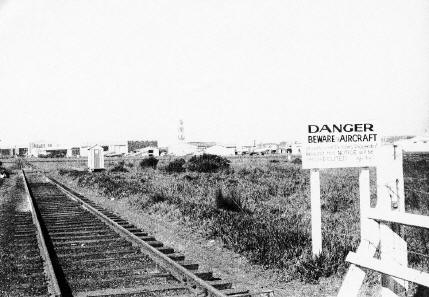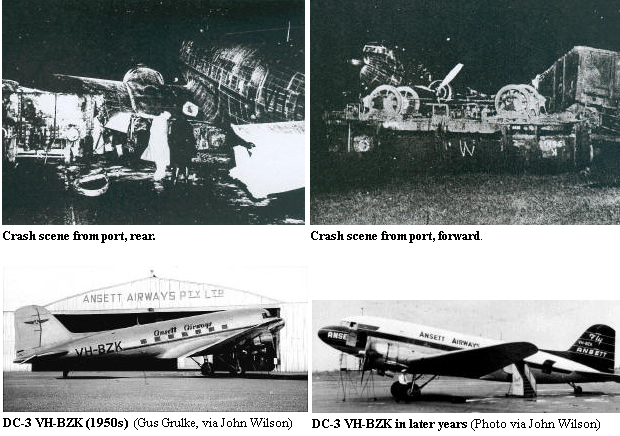History
History : Fred Niven Pages > Plane Meets Train

Plane Meets Train This is the strange story of the collision of Ansett Airways Pty. Ltd.'s Douglas DC-3 (C-47A-25-DK) VH-BZK & a N.S.W. Railways coal train at Kingsford Smith Airport, Mascot, on Sunday 18 June 1950. Much detail has been omitted, for the sake of brevity. The basics are as follows - At approximately 2000 hours on 18 June, 1950, Ansett Airways' DC-3 taxied into empty coal wagons (which were part of a train consisting of a D50 locomotive, 53 empty coal-wagons & 1 brake-van) on Runway 22 at Kingsford Smith Airport, Sydney. The DC-3 was extensively damaged & five of the empty coal wagons were derailed. Only the DC-3's First Officer received minor injuries. The following show (1) the basic layout of the runways, the rail line & the approximate position of the collision & (2) the crash layout details :  There were 3 runways available for use that night - 11/29 (1085m/3580ft), 16/34 (1190m/3950ft) & 04/22 (1787m/5900ft). These are shown clearly in the 1st drawing, above. The following photo (by E.A. Downs) shows the view at about that time, looking east towards Runway 22:  Some 150m from the northern end of Runway 04/22 ran the Sydenham-Botany rail line, which was, supposedly, protected by special safety controls. A north-east extension of Runway 04/22 had been opened on 22 October, 1945, for the 1st time crossing the rail line. A special signaling system was introduced, to allow the train Firemen to communicate with the Mascot Rail Goods Office Control Office & through them seek instructions from the Airport Control Tower. The control tower had facilities to instruct trains whether the rail line was 'clear', or 'obstructed'. At approximately 1916 hours, DC-3 VH-BZK (Capt. R.G. Gibson, F/O Havilland Knott, Hostess Margaret Reid) arrived at Kingsford Smith Airport Runway 16, from an Essendon-Wagga-Wagga-Sydney flight. By 1943 hours, the Control Tower had decided to use Runway 11, instead of Runway 16 &, from then until the accident, all take-offs & landings were made on Runway 11. VH-BZK, readying for a flight to Coffs Harbour & Brisbane, with the same crew of 3 & 15 passengers, called the control tower at 1945. The Airport Controller, W.L. Jeffrey, claimed that he cleared the aircraft to use Runway 11. His assistant, D.R. Morrison, stated that he confirmed that clearance. The Controller then moved on to another aircraft & did not keep track of VH-BZK. However, Capt. Gibson stated that he was instructed to use Runway 22, rather than Runway 11, proceeded along the apron, on the taxiway adjacent to Runway 22, crossing the rail line, without lighting, or problems. At approximately 1955 hours, the signalman in the Mascot Goods Yard phoned the control tower, to seek permission for an empty coal train, from the Bunnerong Power Station to cross the runway. The permission was given for the train to proceed. However, at 1958, the Controller called VH-BZK & advised that he was cleared for take-off, believing that VH-BZK was at the end of Runway 11, rather than Runway 22. The Captain advised 'Tower, Baker Zebra King with you. Ready for take-off. I notice that there are no runway lights." After commencing taxying, the Captain noted the lights on Runway 16. The Control Tower again contacted the aircraft & asked their intensions. The Captain advised that they proposed to take-off, on time, at 2000 &, according to the Captain's evidence to the subsequent inquiry, further advised "I am sitting at the end of Runway Two-Two, because I am under the impression that we were instructed to use Runway Two-Two. As the lights of Runway Two-Two are not on, do you wish us to use Two-Two, or One-Six?" The Control Tower replied 'Now I am muddled. It is not One-Six. It is now One-One". The Captain then advised that he queried "Am I clear to taxi down Runway Two-Two for Runway One-One holding position?" The Control Tower replied "Baker Zebra King, clear down Runway Two-Two to One-One. Stand by & I'll turn on the lights." The lights were turned on & Captain advised the inquiry that they cleared down the runway & took up a holding position, facing the runway. He then put on his headlights & proceeded to taxi onto Runway 22. After lining-up on the runway & confirming that it was clear, he switched off his headlights (because of the rain, which reflected the glare in the darkness). He proceeded to taxi down Runway 22 at some 10-13km/h (6-8 m/ph) (some later reports suggested that it was considerably faster). After taxying some distance, the F/O shouted "Hold it!" At the same moment, the Captain saw a dark object just in front of the aircraft & immediately applied brakes. VH-BZK then hit something (which it was later revealed was the 25th empty wagon) its starboard side & slewed sideways for several seconds. The Captain immediately turned off the fuel supply, which was lucky, as the port engine burst into flames, but was quickly extinguished. The emergency hatch was opened & the crash scene sighted. The Captain then notified the Control Tower & asked for fire tenders - "Tower, Baker Zebra King, pan, pan, pan. Request fire tenders. We have had a collision & are evacuating." The crew then arranged for the passengers to evacuate the aircraft. Once satisfied that all passengers had left the aircraft, the crew also left the aircraft. Considering the possible results of such a collision (the train & empty wagons were estimated to weigh some 450 tonnes), it is remarkable that only the First Officer received any injury, slight lacerations to his face. The aircraft was nowhere near as lucky, suffering far more, including the engines, the port wing, the port tail assembly & the lower fuselage in the cockpit area. It was later repaired by the Fairey-Clyde works, at a cost of £16500. To cover the temporary loss of DC-3 VH-BZK, T.A.A.'s DC-3 VH-TAG was chartered while it was repaired. The 25th coal wagon did not roll over, but ended up sitting under the aircraft's port wing. In addition to the derailed wagons, part of the track was ripped up. Space does not permit detailing the various claims & counter-claims of the parties involved (the Control Tower had run out of tape on its recording machine & there were therefore no recording of the conversations). However, there was considerable discussion on the matter & legal opinion of the time suggested that the Tower Controller would have been considered as negligent, for approving DC-3 VH-BZK to move to Runway 22, having already given approval for the train to cross that runway. In a later, out-of-court, settlement, the Federal Government compensated Ansett Airways with £27000, for its costs, which resulted from the accident [damage to the aircraft (£16500) & the cost of leasing of VH-TAG]. The N.S.W. Railways were compensated with £485. As a result of this accident, industry wags came up with the saying "Don't miss your train connection, fly Ansett". On 10 December 1951, four aircraft traffic lights were installed, to help prevent a repeat of the accident. On 22 March 1960, the rail line was moved some 200m north of its previous site, outside of the airport boundary fence.  Fred Niven (February 2003) (using info from the following article & book & my own files).
Fred Niven (February 2003) (using info from the following article & book & my own files).
References : 'Flightwatch' article for 'Radio & Communications' by David Rolls (Oct. 1998). 'The Story of the Sydenham to Botany Railway' by Neville Pollard, via John Lau. |
||||
|

 Home
Home